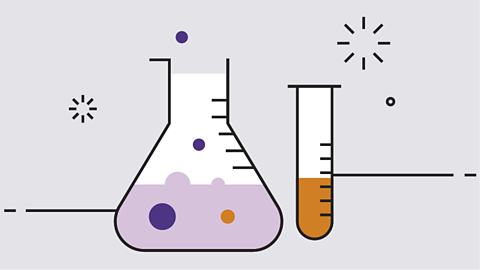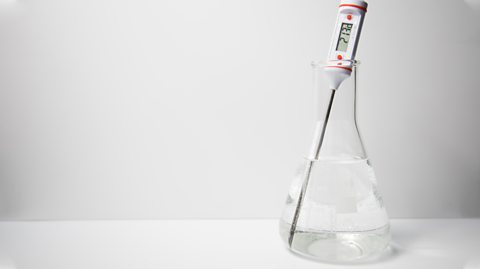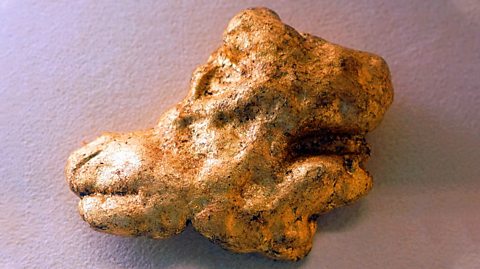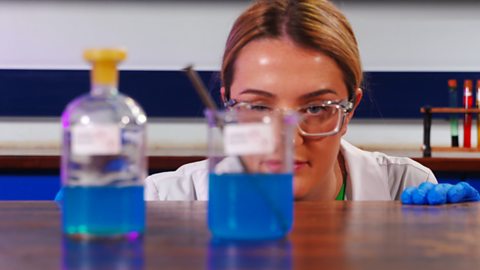Key points
- Metals react differently. Some are very reactive and others are unreactive.
- Observations of reactions can be used to put metals into an order of reactivity.
Copper is used in cooking pots. Is copper a reactive metal?
No, copper is an unreactive metal.
It needs to be unreactive as some foods can be acidic. Acids react with some metals, but generally they don't react with copper.

Reactivity of metals
There are approximately 95 metalA substance which has the typical properties of a metal. Metals are found to the left and in the middle of the periodic table. in the periodic tableA table which lists all of the chemical elements and arranges them in a way that is useful. It allows us to spot patterns and make predictions about other elements..
Metal elementA pure substance that is made from only one type of atom. Elements are listed on the periodic table. Elements cannot be broken down into simpler substances. are found on the left and in the middle of the periodic table. Non-metals are found on the right.
Unreactive metals
Some metals are very unreactiveA substance that does not readily undergo chemical reactions., meaning they don’t easily take part in chemical reactionWhen chemical bonds are broken and made between atoms, so that new substances (compounds or elements) are made..
For example, copper is unreactive so it can be used to make water pipes. This means that the water pipes will never react with the water passing through them.

Did you know?
Hundreds of years ago, water pipes were made from lead. Lead is a very soft metal so was easy for plumbers to shape into pipes. The Latin name for lead is plumbum (element symbol Pb) which gives us the word 'plumbing.'

Reactive metals
Other metals are very reactiveThe tendency of a substance to undergo a chemical reaction., meaning they easily take part in chemical reactions.
Example - lithium
Lithium is an example of a very reactive metal. It is so reactive it has to be kept under oil to prevent it coming in contact with oxygen and moisture in the air. If it did come into contact with the air, it would react very quickly.
When added to a bowl of water, lithium fizzes quickly as hydrogen gas is given off.
If a piece of less reactive copper was placed in a beaker with water, the copper would simply sink to the bottom and not react.
How the reactivity of metals affects their use

The different reactivities influence how the different metals are used.
Unreactive metals can be used as uncombined elements. For example, platinum is used in jewellery because it won’t react with anything, so it stays shiny.
Reactive metals are used mainly in compoundA pure substance made from two or more elements which are chemically bonded in a fixed ratio. and have specialised uses. For example, calcium metal reacts with water to produce bubbles of hydrogen. However, calcium carbonate is found in many rocks used to construct buildings and roads.

Sodium is a metal which has very similar properties to lithium. Why is sodium not used to make cutlery?
Sodium would react very quickly with water to produce hydrogen gas in an exothermic reaction (a reaction that transfers energy to the surroundings).
This would happen whenever the cutlery was put in your mouth or washed up. This would be very dangerous!
Observing reactivity
It is possible to decide an order of reactivity by observing chemical reactions and comparing what is seen.
The chemical reactions of reactive metals will often show visible changes, such as bubbles of gas or flames being formed. However, unreactive metals will show no visible changes.
There are three main reactions of metals that can be used to compare the reactivity of different metals. These are reactions of metals with:
- oxygen
- water
- acids
1. Metals and oxygen
If a metal reacts with oxygen, it produces a metal oxideA compound which contains an element bonded to oxygen. .
metal + oxygen → metal oxide
- the most reactive metals burn in oxygen with a bright flame
- less reactive metals change colour slowly
- the least reactive metals do not react with oxygen
Caesium (Cs) is one of the most reactive metals. It must be stored in sealed glass bottles which contain only caesium and the unreactive gas argon so that no air is present. If the glass bottle is opened, the caesium reacts instantly with oxygen in the air and turns an orange-yellow colour.

Magnesium (Mg) is less reactive than caesium. When magnesium is heated in a Bunsen burner A piece of apparatus that uses gas to apply heat in some experiments. It is named after the chemist, Robert Bunsen. flame it burns in air producing a white flame and leaving magnesium oxide.

Copper (Cu) is even less reactive. When heated in a Bunsen flame, copper slowly changes colour as black copper oxide is produced.
Gold (Au) is one of the least reactive metals and does not react with oxygen, even when heated.
The table shows these metals into an order of reactivity based on observations of how each metal reacts with oxygen. The most reactive metals are at the top of the table and the least reactive metals are at the bottom.
| Reactivity | Metal | Observation |
|---|---|---|
| Most reactive | Caesium (Cs) | Reacts instantly with oxygen in the air |
| ↑ | Magnesium (Mg) | Burns in air producing a white flame when heated in a Bunsen flame |
| ↑ | Copper (Cu) | Slowly changes colour when heated in a Bunsen flame |
| Least reactive | Gold (Au) | No reaction with oxygen |
Describe the different ways that copper and sodium would be stored in a chemistry laboratory.
Sodium would need to be stored under oil (or in sealed bottles containing argon) to prevent it reacting with oxygen in the air.
Copper does not need to be stored in any specific or careful way, because it won’t react with the oxygen in the air.

2. Metals and water
Some metals react with water, but others don’t. When a metal reacts with water, hydrogen gas is produced and this can catch on fire.
The diagram shows four different metals reacting with water:
- A - Lithium (Li)
- B - Calcium (Ca)
- C - Silver (Ag)
- D - Potassium (K)
The table shows these metals into an order of reactivity (from most reactive to least reactive) based on the observations of how the metals react with water.
| Reactivity | Metal | Observation |
|---|---|---|
| Most reactive | D - Potassium (K) | Sparks and a flame produced on contact with cold water |
| ↑ | A - Lithium (Li) | Lots of bubbles and movement with cold water |
| ↑ | B - Calcium (Ca) | Tiny bubbles produced slowly with cold water |
| Least reactive | C - Silver (Ag) | No change |
3. Metals and acids
Acids are solutionA mixture made when a solute (usually a solid) dissolves into a solvent (a liquid). Sea water is a solution of salt dissolved into water. which have a pH scaleA scale which gives a value for how acidic or alkaline a substance is. which is less than 7. The observations when metals react with acidA substance which produces hydrogen ions in solution. Acids have pH values lower than 7. are similar to those with water.
Unreactive metals do not react with acids, however very reactive metals like potassium have a very fast reaction and flames may even be seen.
The diagram shows four different metals reacting with diluteA dilute solution has a low concentration so it is weaker. Liquids are often diluted by adding water. hydrochloric acid:
- A - Zinc (Zn)
- B - Magnesium (Mg)
- C - Sodium (Na)
- D - Copper (Cu)
The table shows four metals into an order of reactivity (from most reactive to least reactive) based on the observations of how the metals react with dilute hydrochloric acid.
| Reactivity | Metal | Observation |
|---|---|---|
| Most reactive | C - Sodium (Na) | Sparks and a flame produced on contact with acid |
| ↑ | B - Magnesium (Mg) | Lots of bubbles and movement |
| ↑ | A - Zinc (Zn) | Tiny bubbles produced slowly |
| Least reactive | D - Copper (Cu) | No change |
Look at the diagram of the reactivity series of different metals and their reactions with dilute acids.
- Platinum to copper are very unreactive metals, so don’t normally react with acids. This means they are placed at the bottom of the reactivity series in the diagram.
- Lead to zinc are more reactive, so produce very small bubbles in a slow reaction. They are placed above platinum and gold.
- Aluminium, magnesium and calcium react quickly with dilute acids, so are placed above zinc.
- Potassium and sodium react violently with dilute acids, producing sparks and perhaps a small explosion. They are placed above these other metals.
Calcium is less reactive than potassium but more reactive than magnesium. Can you suggest what its reaction with a dilute acid would look like?
It would be a very fast reaction, with rapid bubbling.

The reactivity series
A reactivity series of metals can be created using the observations of their reactions with oxygen, water and acid.
The metals which show the fastest and most violent reactions are the most reactive.
Those which show no visible change are the least reactive.
In the reactivity series, the metals are in order of reactivity, with the most reactive metals at the top.

Two non-metals, carbon and hydrogen, are often included in the reactivity series.
This is because they allow us to predict particular chemical reactions.
The Cutty Sark is a famous historic ship used in the late 1800s and early 1900s. The bottom of the ship is coated with a metal which did not react with sea water.
Suggest which metal would be used for this.
The bottom of the Cutty Sark is coated in a mixture of metals, but the majority of the mixture is copper, which is unreactive.
Other unreactive metals (such as gold) would be too expensive.

Working scientifically
Data and observation and the reactivity series
Observations of reactions with oxygen, water and acid have been used to give evidence for making a reactivity series.

The metals which show the most visible changes are considered the most reactive. Those which show no visible changes are considered to be the least reactive.
Data from measurements can also be collected to provide extra evidence for the position of a metal in the reactivity series.

For example, the reaction of metals and acids is exothermicA physical change or chemical reaction that transfers energy to the surroundings.. This means the reaction gives out heat and a temperature rise can be measured.
The table shows data on the temperature rise for four metals reacting with dilute hydrochloric acid.

| Metal | Temperature rise (°C) |
|---|---|
| Copper (Cu) | 0 |
| Zinc (Zn) | 9 |
| Magnesium (Mg) | 32 |
| Iron (Fe) | 6 |
The data shows that magnesium has the highest temperature rise, and copper has no temperature rise. Try and answer these questions based on the observations in the table.
1. What can we conclude from the results about the order of reactivity of all four metals?
This suggests magnesium is the most reactive and copper the least reactive metal.
The order of reactivity from most reactive to least reactive is:
- magnesium
- zinc
- iron
- copper
A metal gives a temperature rise of 14°C when added to some dilute hydrochloric acid.
2. Where would it be placed in the reactivity series?
Above zinc and below magnesium.
Find out more about observation and measurement skills in this guide.
Test your knowledge
Quiz
Play the Atomic Labs game! gamePlay the Atomic Labs game!
Try out practical experiments in this KS3 science game.

More on The reactivity series
Find out more by working through a topic
- count2 of 3

- count3 of 3
